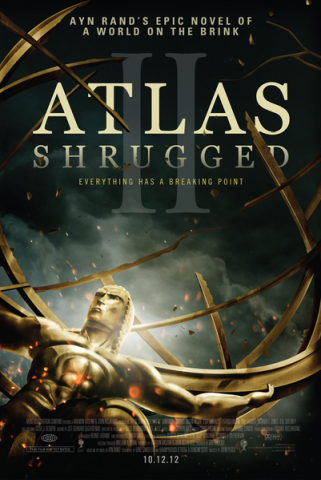
Part 2 of the movie trilogy of Ayn Rand’s novel Atlas Shrugged is, by turns, eerie, chilling, disappointing, and affirming. With twice the budget of Part 1, Atlas Shrugged Part 2 is broader in scope and adheres more closely to the original book. It also has a new cast. Many had high expectations. In some respects it succeeded; in others it didn’t.
Opening like a James Bond thriller, Dagny Taggart (Samantha Mathis) is driving her private jet at maximum velocity in an attempt to follow another pilot over the Colorado mountains. She cries out in exasperation the theme that appears throughout the movie: “Who is John Galt?” The implication is that the other pilot has the answer.
The film flashes back to her frustration nine months earlier when she is unable to learn who invented, and how to make work, an energy generator that operates on static electricity, yielding essentially free energy with no pollution. The story line is simplicity itself: Creative entrepreneurs are deemed to be enemies of the state and their capital (including their patents, ideas, and inventions) must be forcibly relinquished — “gifted,” as government officials put it — to the state, all in the name of egalitarianism.
But why should these entrepreneurs continue to create and produce? Why not simply disappear? One by one that’s exactly what they do — leaving behind the message “Who is John Galt?” Without their hard work and creative juices, the economy, already weakened by government intervention in the marketplace, can only get worse. How could it be otherwise when Atlas, battered and bleeding while still straining under the burden of the world on his shoulders, finally shrugs?
With six protagonists and five antagonists, the film could have been simple to produce. But with 56 other secondary characters, some assuming major but brief roles in the film, the story line is interrupted frequently, sometimes unforgivably so.
The film was eerie as it showed gasoline selling for $42.50 a gallon, costing Taggart nearly $865 to put 20 gallons into her truck. The film also managed to show downtown streets nearly deserted except for some on bicycles.
It had chilling moments, such as the “star chamber” scene where Hank Rearden (Jason Beghe) is being charged at a Unification Board Meeting — essentially a Star Chamber — with violating the latest of draconian regulations: doing business with a friend. His penalty: a $50 million fine and 10 years in jail.
And another when incompetence meets politics: the head-on collision between two trains deep inside the Taggart Tunnel in Colorado, killing all aboard.
It was disappointing in that Rand’s stiff dialogue, carefully softened in Part 1, was allowed to control the conversations in Part 2, leaving the characters flat and bland and largely uninteresting. Lillian (Kim Rhodes), Rearden’s jilted and jealous wife is evil incarnate but is not allowed to develop fully in the film. In general, the film seemed to be put together in a rush, in an attempt to meet some deadline. (The producer said that investors in the project were hoping to have an impact on the upcoming election, and that obviously hurried the project, to its detriment.)
There were great moments of clarity and affirmation for the Randian faithful. In his Star Chamber rebuttal, Rearden challenged the judges with having no authority to charge him with doing anything wrong. He accused them of being in the employ of looters – of “stealing their power from our freedom.” This brought huzzahs from the court’s audience. But even in that moment of challenge by an individual to the power of the state to steal under the guise of law, the film fails to present the real agony Rearden is suffering: How can such vermin have such influence? What has happened to morality in a world gone mad? He asks, as he leaves the courtroom: “How can such small people do so much damage?”
Another moment of affirmation about how the free market works to solve problems that government cannot, while providing for the needs and wants of unknown participants in that market, came when Taggart confronts Ken Danagger (Arye Gross), the owner of Danagger Coal in Pennsylvania. She urges him not to give up but to stay and fight the tentacles of overweening government. Danagger’s coal is purchased by Rearden, who uses it to make his special metal rails, which is purchased by Taggart to build her railroad, which hauls Danagger’s coal. Danagger says that it’s a “perfect balance.” But it’s a balance that is thrown inevitably into disarray by government bureaucrats — the looters and moochers and cheaters, as Rand calls them.
Two characters especially stand out: the perfect arrogant government bureaucrat with too much authority, Wesley Mouch (Paul McCrane), and Francisco d’Anconia (Esai Morales), the poor little rich kid playboy who destroyed his family’s copper mines to keep them from being looted by the government. Each brought life and breath and color to an otherwise staid and cold and uninteresting series of characters.
To make a fine point: In an attempt to make the film appear to be relevant and current to today, two current idioms were jarringly inserted into the dialogue: “catchy,” when Rearden learned that the government was going to rename his Rearden Metal into “Miracle Metal”; and “How’s that workin’ for ya?” when d’Anconia confronted James Taggart.
The faithful will applaud the message in Atlas Shrugged Part 2 and will want to see the final installment when it comes out. But how about the uninitiated? Regular moviegoers who just happened to buy a ticket for an evening of entertainment will likely be bewildered and disappointed — and left wondering what all the fuss was about. Any impact on the election in November is dubious at best.
Related article:



